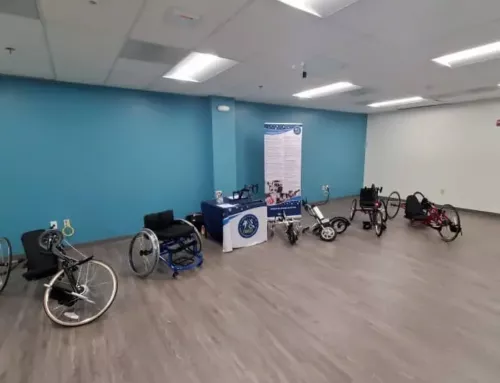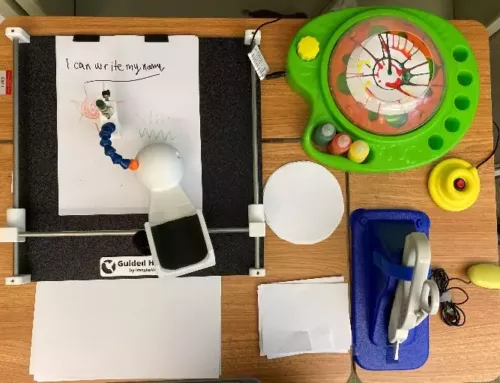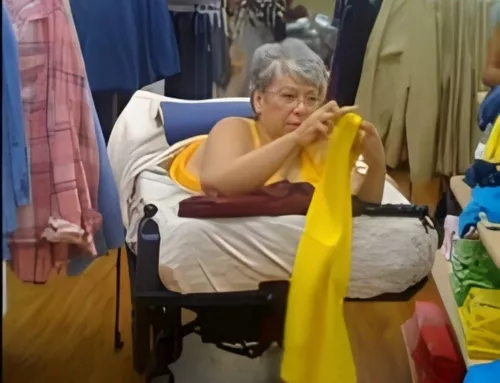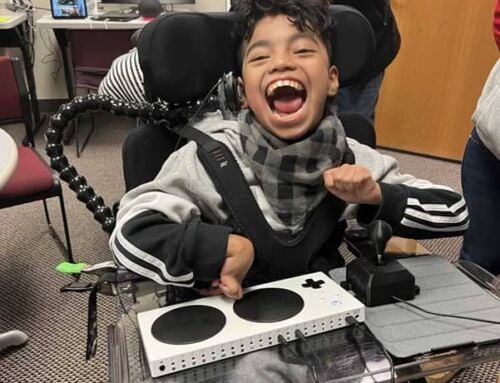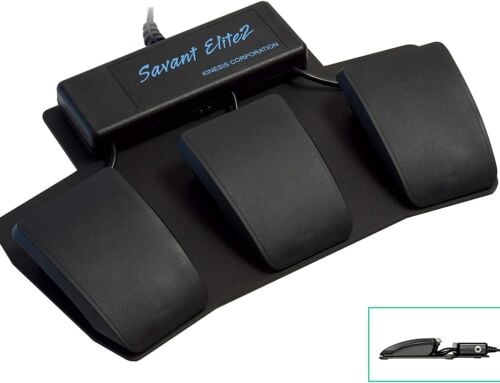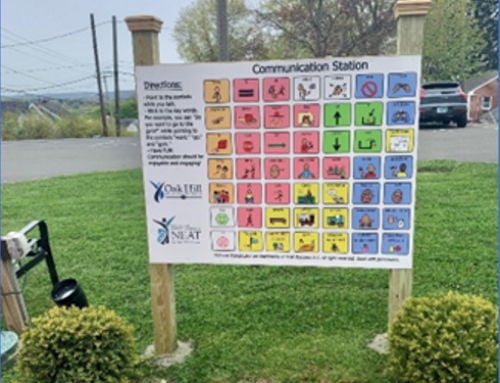A Unique Partnership Brings the Jaco II Robotic Arm to AzTAP
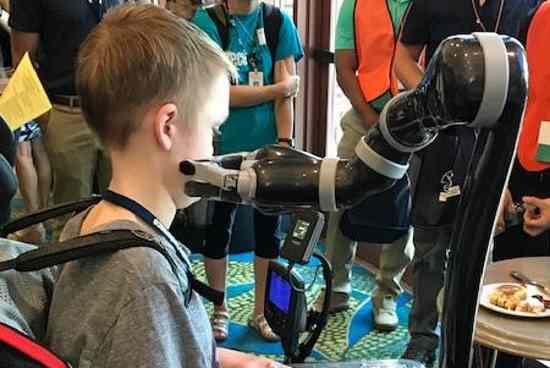
Thanks to the Assistive Technology (AT) Act of 1998, each US state and territory has a program where anyone may see and try out assistive technology free of charge for use at home, school, work or in their communities. Equipment that is common to the State AT Program inventories ranges from medication dispensers and adaptive eating utensils to computers and speech generating devices. With technology advancing at such a rapid pace, however, it is challenging for programs to stock costly devices not yet prevalent in the marketplace. This year the Arizona Technology Access Program (AzTAP) took advantage of a unique way to do so through a partnership with Kinova Robotics and inspired by a young man named Ryan Cotter.
The Kinova Jaco II robotic arm is designed for individuals who do not have functional use of their arms or hands by giving a user the ability to reach and grasp. The Jaco II attaches to a power wheelchair and makes simple daily activities possible: holding a fork or glass, picking up something from the floor, getting a snack from the fridge, whatever a person needs and wants to do.
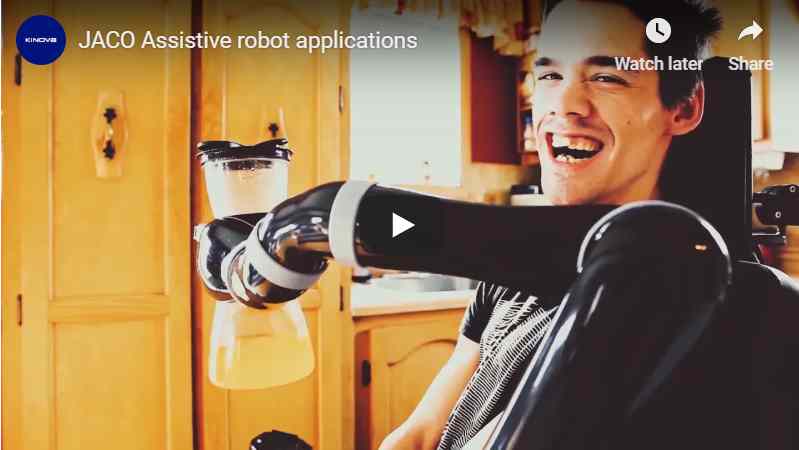 [The above YouTube video, “JACO Assistive robot applications,” features different JACO users (without sound or captions) performing a variety of tasks including opening a drawer, selecting clothes from a closet, food from the fridge, eating and drinking, retrieving a page of paper from a copier, building with small blocks, and feeding a biscuit to a dog.]
AzTAP first learned of the arm from Kinova Robotics but had the opportunity to see it demonstrated by Ryan Cotter, a young man with spinal muscular atrophy who had defied the odds and was planning on using his Jaco arm upon entering Arizona State University in 2019. AzTAP has known Ryan and his family for many years and had worked with Ryan on more than one occasion. Last summer, Ryan was happy to show his robotic arm at the AzTAP conference and he made a strong impression. “What struck me most was when I saw Ryan just idly scratch his cheek,” AzTAP Director Jill Pleasant reflects. “It was such a common gesture and such a basic need.”
[The above YouTube video, “JACO Assistive robot applications,” features different JACO users (without sound or captions) performing a variety of tasks including opening a drawer, selecting clothes from a closet, food from the fridge, eating and drinking, retrieving a page of paper from a copier, building with small blocks, and feeding a biscuit to a dog.]
AzTAP first learned of the arm from Kinova Robotics but had the opportunity to see it demonstrated by Ryan Cotter, a young man with spinal muscular atrophy who had defied the odds and was planning on using his Jaco arm upon entering Arizona State University in 2019. AzTAP has known Ryan and his family for many years and had worked with Ryan on more than one occasion. Last summer, Ryan was happy to show his robotic arm at the AzTAP conference and he made a strong impression. “What struck me most was when I saw Ryan just idly scratch his cheek,” AzTAP Director Jill Pleasant reflects. “It was such a common gesture and such a basic need.”
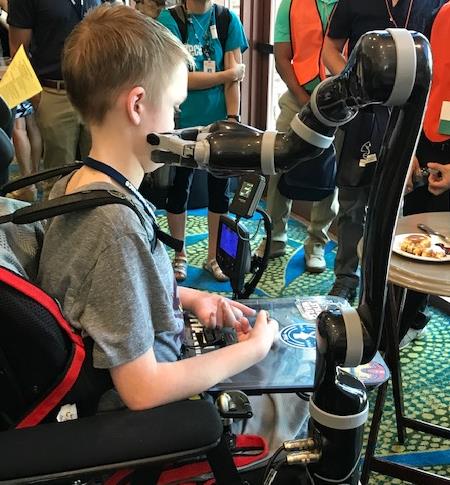
Ryan with the Jaco II
“It was a win-win opportunity,” Pleasant explains. “The device can be fundable through Medicaid as a wheelchair accessory and by placing one with us, Arizona DME vendors have equal access to borrowing it, so more wheelchair users can see if it works for them.”
AzTAP acquired their Jaco late in the summer. Since then, the arm has been demonstrated to 52 occupational therapy students from a local university and borrowed for trial with four DME clients. “It is a wonderful opportunity for us and wheelchair users who can benefit,” Pleasant says. “I recall seeing one client in the elevator, using the arm to select a floor button. The arm costs over $50,000. It would be next to impossible for us to have it any other way.”
The AT3 Center is reaching out to Kinova about this partnership with plans for a future webinar for State AT Programs who are interested.
AT3 Center and AzTAP were sad to learn of the sudden passing of Ryan Cotter after commencing work on this article. He and his family have had a lasting impact on families and children with disabilities and terminal conditions in Arizona (please see Ryan House). The Kinova robotic arm at AzTAP is just a small piece of Ryan’s enormous legacy.
Find Your State AT Program
Monthly Blog Digest
Search the blog
State AT Program Blogs
California
Florida
Indiana
Kentucky
Louisiana
Maryland
Massachusetts
Michigan
Montana
North Carolina
North Dakota
Utah
State AT Program Blogs
The AT3 Center, the Association of AT Act Programs (ATAP), and the Administration on Community Living (ACL) make no endorsement, representation, or warranty expressed or implied for any product, device, or information set forth in this blog. The AT3 Center, ATAP, and ACL have not examined, reviewed, or tested any product or device hereto referred.



